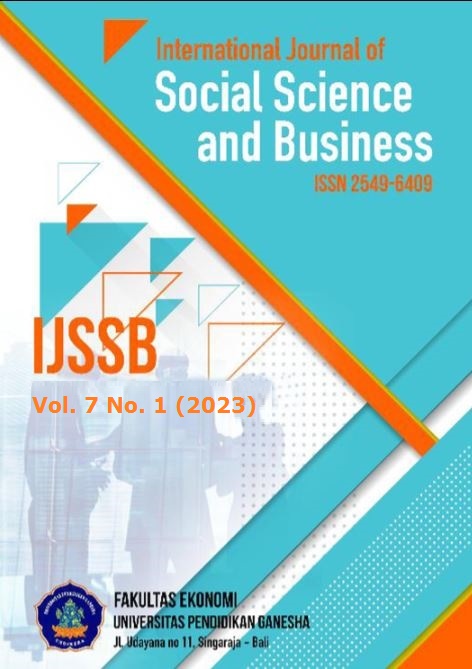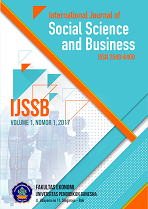Overview of Work Engagement with Remote Worker
DOI:
https://doi.org/10.23887/ijssb.v7i1.51383Keywords:
remote worker, work engagement, work from homeAbstract
Work from home, or WFH, has been implemented since the COVID-19 pandemic. WFH, or work from home, has existed since the past, but it is not used in COVID-19 and is used in normal situations. With the work-from-home, the system also changed. This system was called a Remote worker. This study aims to analyze the description of remote workers experienced by workers. This type of research was qualitative research with phenomenological methods. Data collection methods used interviews and observation. The data collection technique used was the purposive sampling technique. While the data analysis techniques used consisted of preparing the data, reading the entire data, coding the data, applying the results of data coding into themes to be analyzed, presenting the themes in narrative form, and interpreting the data. The results showed that the four subjects, NH, MR, ISF, and LA, experienced increased motivation in remote workers. Other findings show that while working from home, the subject had good productivity and work resilience. It was influenced by factors within each of them when they decided to work remotely. Based on the results of the study, it can be concluded that remote workers have an increase in motivation through work from home (WFH). In addition, it was found that remote workers are more productive and have good fighting power. These findings reinforce that remote work also makes workers engaged in work even more engaged.
References
Alghaithi, A., & Sartawi, P. K. (2020). Improving Remote Employees ’ Organi sational Productivity – Practical Guidelines for Identifying and Managing Bottlenecks in T oday ’ s World. 22(2), 63–74. https://doi.org/10.9790/487X-2202046374.
Amir, M., & Mangundjaya, W. L. (2021). How Resilience Affects Employee Engagement? A Case Study in Indonesia. Journal of Asian Finance, Economics and Business, 8(2), 1147–1156. https://doi.org/10.13106/jafeb.2021.vol8.no2.1147.
Andreas, D. (2022). Employee performance: the effect of motivation and job satisfaction. PRODUKTIF: Jurnal Kepegawaian Dan Organisasi, 1(1), 28–35.
Beauregard, T. A., Basile, K. A., & Canonico, E. (2019). Telework: Outcomes and facilitators for employees. In The Cambridge Handbook of Technology and Employee Behavior (Issue February). https://doi.org/10.1017/9781108649636.020. DOI: https://doi.org/10.1017/9781108649636.020
Bloom, N. (2014). To raise productivity, let more employees work from home. Harvard Business Review, JAN-FEB.
Cooke, F. L., Cooper, B., Bartram, T., Wang, J., & Mei, H. (2019). Mapping the relationships between high-performance work systems, employee resilience and engagement: a study of the banking industry in China. International Journal of Human Resource Management, 30(8), 1239–1260. https://doi.org/10.1080/09585192.2015.1137618. DOI: https://doi.org/10.1080/09585192.2015.1137618
Crawford, J. O., MacCalman, L., & Jackson, C. A. (2011). The health and well-being of remote and mobile workers. Occupational Medicine, 61(6), 385–394. https://doi.org/10.1093/occmed/kqr071. DOI: https://doi.org/10.1093/occmed/kqr071
Creswell, J. W. (2013). Research Design: Qualitative, Quantitative, and Mixed Methods Approaches. SAGE Publications, Inc.
Farooq, R., & Sultana, A. (2021). The potential impact of the COVID-19 pandemic on work from home and employee productivity. Measuring Business Excellence, July. https://doi.org/10.1108/MBE-12-2020-0173. DOI: https://doi.org/10.1108/MBE-12-2020-0173
Jalagat, R.C., J., & Jalagat, A. M. (2019). Rationalizing Remote Working Concept and Its Implications on Employee Productivity. Global Journal of Advanced Research, 6(3), 95–100. https://ejournal.unesa.ac.id/index.php/character/article/view/41162.
Johnson, H., Worthington, R., Gredecki, N., & Wilks-Riley, F. R. (2016). The impact of forensic work on home life: the role of emotional labour, segmentation/integration and social support. Journal of Forensic Practice, 18(1), 52–63. https://doi.org/10.1108/JFP-05-2015-0029. DOI: https://doi.org/10.1108/JFP-05-2015-0029
Kazekami, S. (2020). Mechanisms to improve labor productivity by performing telework. Telecommunications Policy, 44(2), 101868. https://doi.org/10.1016/j.telpol.2019.101868. DOI: https://doi.org/10.1016/j.telpol.2019.101868
Lee, H. (2021). Changes in workplace practices during the COVID-19 pandemic: the roles of emotion, psychological safety and organisation support. Journal of Organizational Effectiveness, 8(1), 97–128. https://doi.org/10.1108/JOEPP-06-2020-0104. DOI: https://doi.org/10.1108/JOEPP-06-2020-0104
Maura Magnalia, U. A. (2021). PERBEDAAN WORK ENGAGEMENT DITINJAU DARI MASA KERJA PADA KARYAWAN BAGIAN PRODUKSI | Character: Jurnal Penelitian Psikologi. Character: Jurnal Penelitian Psikologi, 08(03), 24–35. https://ejournal.unesa.ac.id/index.php/character/article/view/41162.
Messenger, J. C., & Gschwind, L. (2016). Three generations of Telework: New ICTs and the (R)evolution from Home Office to Virtual Office. New Technology, Work and Employment, 31(3), 195–208. https://doi.org/10.1111/ntwe.12073. DOI: https://doi.org/10.1111/ntwe.12073
Monteiro, N. P., Straume, O. R., & Valente, M. (2021). Does Remote Work Improve or Impair Firm Labour Productivity? Longitudinal Evidence from Portugal. SSRN Electronic Journal. https://doi.org/10.2139/ssrn.3507262. DOI: https://doi.org/10.2139/ssrn.3507262
Mustajab, D., Bauw, A., Rasyid, A., Irawan, A., Akbar, M. A., & Hamid, M. A. (2020). Working From Home Phenomenon As an Effort to Prevent COVID-19 Attacks and Its Impacts on Work Productivity. TIJAB (The International Journal of Applied Business), 4(1), 13. https://doi.org/10.20473/tijab.v4.i1.2020.13-21. DOI: https://doi.org/10.20473/tijab.V4.I1.2020.13-21
Nield, D. (2016). People who work remotely are happier and more productive, study finds. Science Alert.
Nurhasanah, D., & Winarno, A. (2021). PENGARUH WORK FROM HOME TERHADAP MOTIVASI KERJA KARYAWAN SELAMA PANDEMI COVID 19 ( Studi Di Kantor BPJS Ketenagakerjaan Cabang Soekarno Bandung ) THE EFFECT OF WORK FROM HOME ON EMPLOYEE WORK MOTIVATION DURING THE COVID 19 PANDEMIC ( Study at the Office o. E-Proceeding of Management, 8(5), 6535–6547. https://openlibrarypublications.telkomuniversity.ac.id/index.php/management/article/view/16527.
Ojo, A. O., Fawehinmi, O., & Yusliza, M. Y. (2021). Examining the predictors of resilience and work engagement during the covid-19 pandemic. Sustainability (Switzerland), 13(5), 1–18. https://doi.org/10.3390/su13052902. DOI: https://doi.org/10.3390/su13052902
Patria, N. S. (2020). Pengaruh Work From Home Terhadap Motivasi Dan Kinerja (Studi Pada Karyawan Bagian Back Office PT. New Priok Container Terminal 1 Jakarta Utara). Jurnal Ilmiah Mahasiswa FEB Universitas Brawijaya, 9(2), 1–17. https://jimfeb.ub.ac.id/index.php/jimfeb/article/view/7440.
Peeters, M. C. W., Jonge, J. de, & Taris, T. W. (2014). An Introduction to Contemporary Work Psychology. In Industry Week (Vol. 249, Issue 15). Wiley Blackwell. https://doi.org/10.4324/9780429055843-16. DOI: https://doi.org/10.4324/9780429055843-16
Pura, J. J. (2022). Linking Motivation and Employee Engagement through Gamification in Remote Working. International Journal of Academe and Industry Research, 3(1), 52–69. https://doi.org/10.53378/352857. DOI: https://doi.org/10.53378/352857
Sadida, N. (2013). Mengoptimalkan Penerapan Telecommuting dalam Meningkatkan Produktivitas dan Motivasi Kerja Karyawan. Conference: Temu Ilmiah Psikologi Nasional Indonesia, December 2013, 1–12. https://www.researchgate.net/profile/Nuri-Sadida/publication/325313118_Mengoptimalkan_Penerapan_Telecommuting_dalam_Meningkatkan_Produktivitas_dan_Motivasi_Kerja_Karyawan/links/5b05194baca2720ba09a208e/Mengoptimalkan-Penerapan-Telecommuting-dalam-Meningkatkan-Produktivitas-dan-Motivasi-Kerja-Karyawan.pdf.
Salma Sultana, U., Abdullah, A., Teng Mok, E., Hossain, J., Rehman Sherief, S., Lutfi Iskandar, M., & Warda Andalib, T. (2021). Exploring Motivation and Commitment on Job Satisfaction and Employee Performance in Work from Home (WFH) Perspective. Psychology and Education, 58(3), 2411–2424. www.psychologyandeducation.net.
Schaufeli, W. B. (2012). Work engagement: what do we know and where do we go? Romanian Journal of Applied Psychology, 14(1), 3.10. https://doi.org/10.1177/0011000002301006. DOI: https://doi.org/10.1177/0011000002301006
Stasiuk-Piekarska, A. (2021). The Impact of Remote Work on Human Well-Being. European Research Studies Journal, XXIV(Special Issue 5), 726–741. https://doi.org/10.35808/ersj/2762. DOI: https://doi.org/10.35808/ersj/2762
Susilo, D. (2020). Revealing the Effect of Work-From-Home on Job Performance during the Covid-19 Crisis: Empirical Evidence from Indonesia. Journal of Contemporary Issues in Business and Government, 26(01), 23–40. https://doi.org/10.47750/cibg.2020.26.01.002. DOI: https://doi.org/10.47750/cibg.2020.26.01.002
Veld, M., van der Heijden, B. I. J. M., & Semeijn, J. H. (2016). Home-to-work spillover and employability among university employees. Journal of Managerial Psychology, 31(8), 1280–1296. https://doi.org/10.1108/JMP-09-2015-0347. DOI: https://doi.org/10.1108/JMP-09-2015-0347
Wang, Z., Li, C., & Li, X. (2017). Resilience, Leadership and Work Engagement: The Mediating Role of Positive Affect. Social Indicators Research, 132(2), 699–708. https://doi.org/10.1007/s11205-016-1306-5. DOI: https://doi.org/10.1007/s11205-016-1306-5
Downloads
Published
How to Cite
Issue
Section
License
Copyright (c) 2022 Muhammad Ali Adriansyah, Firda Apriliana, Elling Rikza Nadzifah, Annisa Afifah Febrianti, Shinta Aprillia Pramesti

This work is licensed under a Creative Commons Attribution-ShareAlike 4.0 International License.











